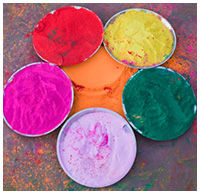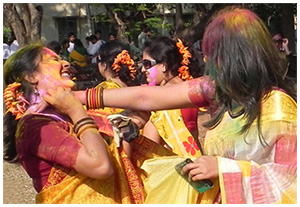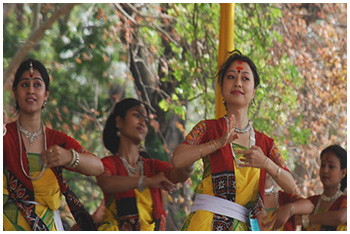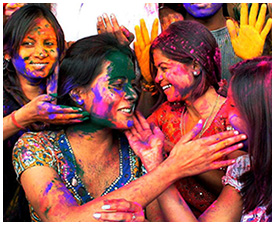Holi Celebrations in India
The ancient Holi festival is something that
every Hindu looks forward to. In India, this splendid occassion is annually
observed in a grand manner and with the performance of unique rituals.
Colourful celebrations, bonfires, cultural programmes, spring rites - all
these and more form inseperable parts of the Indian Holi festival. Here we
bring you an informative as well as entertaining article on Holi
celebrations in India and the traditions observed during the occassion. If
you like reading about Holi celebrations in India,
click here and refer this page to
your friends and dear ones. TheHolidaySpot wishes you a happy Holi. Holi Hai!
The celebration of Holi has different aspects.
It is a celebration of the triumph of good over evil, a carnival of
colors,
a community festival, and a tradition of ancient spring rites,
The evening of bonfires:
 The day before the full moon day of the Holi is called as the Small
Holi.
Children lit up bonfires and sing and dance around it.
The evil spirit, symbolized by all those dead leaves, twigs, dirt
and filth that collects during the winter months, is thrown up in the
fire.
Quite a spring cleaning indeed!
The day before the full moon day of the Holi is called as the Small
Holi.
Children lit up bonfires and sing and dance around it.
The evil spirit, symbolized by all those dead leaves, twigs, dirt
and filth that collects during the winter months, is thrown up in the
fire.
Quite a spring cleaning indeed!
People sometimes take embers from the fire to their homes to rekindle their own domestic fires. In some community, a pot of new barley seeds is placed for roasting under the pyre before the bonfire is lit up. These seeds are eaten after the fire dies down. The yields in the coming harvest season are predicted by reading the direction of the flames or by the state of the roasted seeds in the pot.
The ashes from the Holi fire are also believed to provide protection against diseases. It's something similar to the ancinet rites of burning Maypole in the West part of the globe.
The carnival of colors:
The main event of Holi is indeed a carnival of colors. On this day, children, friends and neighbors come out on the streets. And the spree to color-anyone-you-see takes over. Colors of all form and variety. They come in shades of red, orange, blue, green, and purple, and the likes. And they are available in oil, water or powder base.
 Colored powder, or, gulal was earlier made out of Dried seeds
of some tropical flowers like the Palash, and dried silt from the
riverbed.
This has now given way to synthetic dyes, available in the form of
pigments.
For a glittering effect, fine dust of Mica are also mixed with the
powdered dye.
People throw these colored powders in the air as they shout "Holi Hai!",
and smear each other with this colored powder.
Colored powder, or, gulal was earlier made out of Dried seeds
of some tropical flowers like the Palash, and dried silt from the
riverbed.
This has now given way to synthetic dyes, available in the form of
pigments.
For a glittering effect, fine dust of Mica are also mixed with the
powdered dye.
People throw these colored powders in the air as they shout "Holi Hai!",
and smear each other with this colored powder.
Also they wet each other with colored water from Pitchkaris. Colored water is prepared by mixing the pigments of synthetic dyes. These dyes are available in a range of shades. These are sold by most of the local grocers and special purpose kiosks which crop up only for those Holi days. These outlets also sell other Holi accessories, like Pitchkaris, balloons, and head gears, along with coloring pigments. A Pitchkari is a kind of long syringe or sprinkler throwing jets of water from a distance. Also water-filled baloons are used these days to charge the target with a splash of color. Indeed the effect is blasting enough to be taken aback. So don't get shocked if you go out in the streets, on this day, and suddenly, a balloon darts at you, leaving you wet and colored!
Community festival:
It is a community festival that bridges the social gap. People color each other with gulal and other form of dyes. Young men throw coloured powder and coloured water on women. They also visit homes, distribute sweets and greet each other. Men, women, adult and children all take part in dances and other cultural programs.
Holi bears close similarities with the important ancient festival called Vasantotsava, an age-old tradition of celebrating the arrival of spring. This festival was celebrated as a day when people forgot caste and gender differences and were allowed many liberties, otherwise forbidden. And like any spring festival celebrated by ancient peoples all over the world, Vasantotsava also had certain rites. These include lighting up of fires, driving off demons, setting the normal orders in reverse, sporting something weird, having a community feast, and so on.
the no-holds-barred play with colors between young men and women, taking out processions in weird gears, the greetings with yummy sweet dishes the bonfires in the evening before the full moon night of the Holi, are all leftovers of those ancient spring rites.
TheHolidaySpot, has captured some glimpses of this wonderfully serene, rich with culture and classy Springfest, and presents it in its most original form to you.
![]()


The evening of bonfires:
 The day before the full moon day of the Holi is called as the Small
Holi.
Children lit up bonfires and sing and dance around it.
The evil spirit, symbolized by all those dead leaves, twigs, dirt
and filth that collects during the winter months, is thrown up in the
fire.
Quite a spring cleaning indeed!
The day before the full moon day of the Holi is called as the Small
Holi.
Children lit up bonfires and sing and dance around it.
The evil spirit, symbolized by all those dead leaves, twigs, dirt
and filth that collects during the winter months, is thrown up in the
fire.
Quite a spring cleaning indeed!People sometimes take embers from the fire to their homes to rekindle their own domestic fires. In some community, a pot of new barley seeds is placed for roasting under the pyre before the bonfire is lit up. These seeds are eaten after the fire dies down. The yields in the coming harvest season are predicted by reading the direction of the flames or by the state of the roasted seeds in the pot.
The ashes from the Holi fire are also believed to provide protection against diseases. It's something similar to the ancinet rites of burning Maypole in the West part of the globe.
The carnival of colors:
The main event of Holi is indeed a carnival of colors. On this day, children, friends and neighbors come out on the streets. And the spree to color-anyone-you-see takes over. Colors of all form and variety. They come in shades of red, orange, blue, green, and purple, and the likes. And they are available in oil, water or powder base.
 Colored powder, or, gulal was earlier made out of Dried seeds
of some tropical flowers like the Palash, and dried silt from the
riverbed.
This has now given way to synthetic dyes, available in the form of
pigments.
For a glittering effect, fine dust of Mica are also mixed with the
powdered dye.
People throw these colored powders in the air as they shout "Holi Hai!",
and smear each other with this colored powder.
Colored powder, or, gulal was earlier made out of Dried seeds
of some tropical flowers like the Palash, and dried silt from the
riverbed.
This has now given way to synthetic dyes, available in the form of
pigments.
For a glittering effect, fine dust of Mica are also mixed with the
powdered dye.
People throw these colored powders in the air as they shout "Holi Hai!",
and smear each other with this colored powder.Also they wet each other with colored water from Pitchkaris. Colored water is prepared by mixing the pigments of synthetic dyes. These dyes are available in a range of shades. These are sold by most of the local grocers and special purpose kiosks which crop up only for those Holi days. These outlets also sell other Holi accessories, like Pitchkaris, balloons, and head gears, along with coloring pigments. A Pitchkari is a kind of long syringe or sprinkler throwing jets of water from a distance. Also water-filled baloons are used these days to charge the target with a splash of color. Indeed the effect is blasting enough to be taken aback. So don't get shocked if you go out in the streets, on this day, and suddenly, a balloon darts at you, leaving you wet and colored!
Community festival:
It is a community festival that bridges the social gap. People color each other with gulal and other form of dyes. Young men throw coloured powder and coloured water on women. They also visit homes, distribute sweets and greet each other. Men, women, adult and children all take part in dances and other cultural programs.

Holi bears close similarities with the important ancient festival called Vasantotsava, an age-old tradition of celebrating the arrival of spring. This festival was celebrated as a day when people forgot caste and gender differences and were allowed many liberties, otherwise forbidden. And like any spring festival celebrated by ancient peoples all over the world, Vasantotsava also had certain rites. These include lighting up of fires, driving off demons, setting the normal orders in reverse, sporting something weird, having a community feast, and so on.

the no-holds-barred play with colors between young men and women, taking out processions in weird gears, the greetings with yummy sweet dishes the bonfires in the evening before the full moon night of the Holi, are all leftovers of those ancient spring rites.
TheHolidaySpot, has captured some glimpses of this wonderfully serene, rich with culture and classy Springfest, and presents it in its most original form to you.

Click here to uncover this rich world of heritage and celebrations!
Lathmar Holi:
Lathmar holi takes place well before the actual Holi in the town of Barsana near Mathura in the state of Uttar Pradesh, and its celebration is limted to that area. However, the novelty, and the ages of celebration it has gone through, has earned its own fame. Some places emulate the celebration for fun. Click here to find more information on Lath mar Holi.

 Mother's Day
Mother's Day Passover
Passover Good Morning
Good Morning